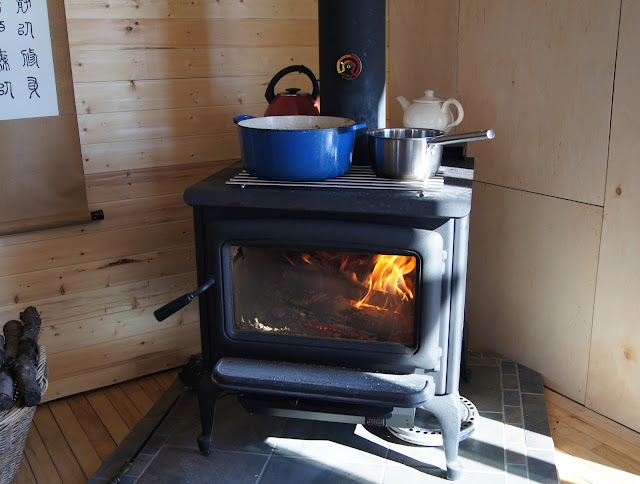We’ve been on a steady venison diet here lately, thanks to
one happy occurrence—the generous gift of a leg of venison from a friend—and
one less fortunate one—the freezer dying on our spare fridge in the
basement. The venison had been in our
freezer since it was passed along to me last fall, and as I was going to have
to thaw it out all at once, I was waiting for the right moment. But sometimes you choose your moment, and
sometimes it is thrust upon you. Hence,
necessity being the mother of invention and all that, I got to work
processing. I was not a very experienced
deer meat cook when I walked upstairs with that dripping, leg-shaped package;
I’m a much more confident one now.
In the last three weeks I’ve prepared venison goulash,
seared rye-crusted medallions, and that pan roast, which I’ve put to use in
numerous ways. But by far the most
interesting and delectable preparation was this smoked venison “pastrami”.
I started by breaking the leg down into its component muscle
groups. Not all cuts of meat consist of
a single muscle, of course—many are cross-sections of several groups. But I don’t have a meat saw, and taking it
apart at the seams, as it were, was the easiest, most logical thing to do. I wound up with about a pound and a half of
the dense meat from the shank, and several nice lean pieces from the upper leg,
each around a pound and a half, also.
What looked at first like an enormous hunk of deer flesh yielded 8 or 9
pounds of usable meat—oh, and another pound-plus of trimmings, which the dogs
greatly enjoyed.
To see what I was dealing with, I sliced off a small piece
from each chunk and fried them briefly to assess the flavor and texture. There were variations—this one a little more
tender, this one a bit livery, etc.—but all were relatively tasty and
tender. They were, in effect, no
different from something like the sirloin or top round cuts of beef. The shank meat was destined for goulash. From the other pieces I selected one to do
the pan roast, and set a long, tenderloin-shaped cut aside to make medallions,
and the last piece, more or less rectangular and about two-inches thick in the
middle, I decided to smoke.
I cured it with a dry rub, and went for some fairly
aggressive seasonings. Here’s the recipe
(chalkboard paint is fun…):
Hua jiao, once again, is Sichuan pepper, in this case the dry-roasted
and ground up kind. Ginger is the dry
spice, chile a dried red one. I used
locally produced maple sugar, but you could substitute brown sugar in the same
amount, or maple syrup, say 1 ½ tablespoons.
I massaged the meat with the seasonings and stuck it in the fridge for a
couple of days, turning it several times.
Not a lot of liquid came off.
Then I smoked it in my trusty Meco grill for about two hours
at about 225, and I used wild black cherry as the main smoking wood, something
I haven’t tried before. The end result was a delightful confluence of happenstance and experiment. I
had no idea what the final product would look or taste like. It smelled fantastic coming off the grill,
and when I cut into it I was amazed at the color. The taste is deep, layered, mysterious, and
wild, but with a delicate texture that makes it seem refined, as well. Really cool stuff. What it reminded me of most was pastrami,
which is smoked corned beef, so I guess that makes sense.
I have cooked slices to serve with eggs and polenta, and
that was good, but I think it’s best straight up, on a slice of toasted country
bread. The sauce gribiche variation I
came up with to accompany it doesn’t detract. This is a really good time of year to dip into the pickle pantry for fresh and crunchy flavors. The rhubarb pickles I made last summer have mellowed really nicely. The sauce is composed of:
A grated hard-cooked egg
Dollop of Hellmann’s mayonnaise
A minced pickled ramp and a little of the pickling brine
Same amount minced pickled rhubarb
6 or 7 minced milkweed bud “capers”
A half teaspoon or so of sambal



















